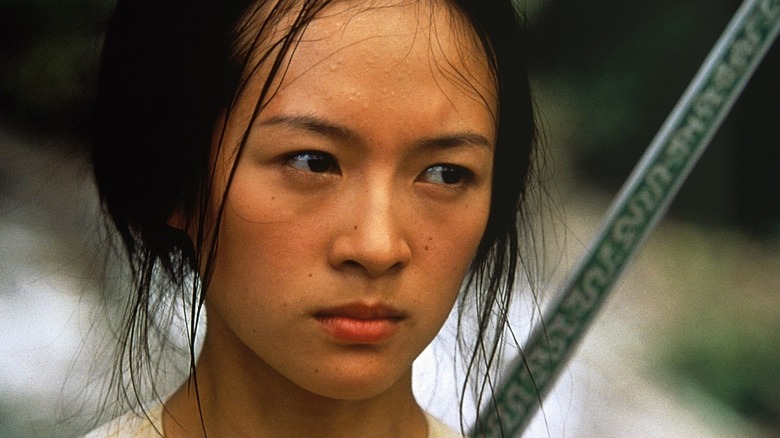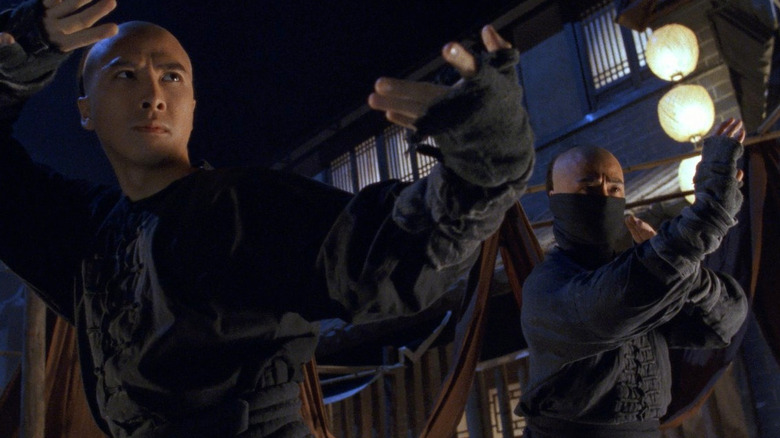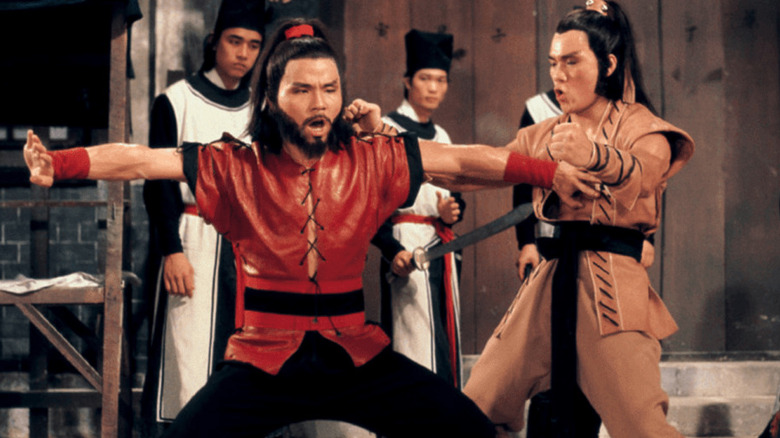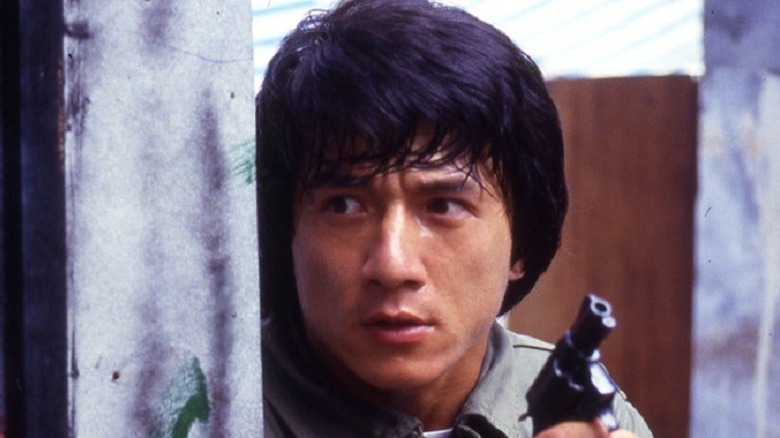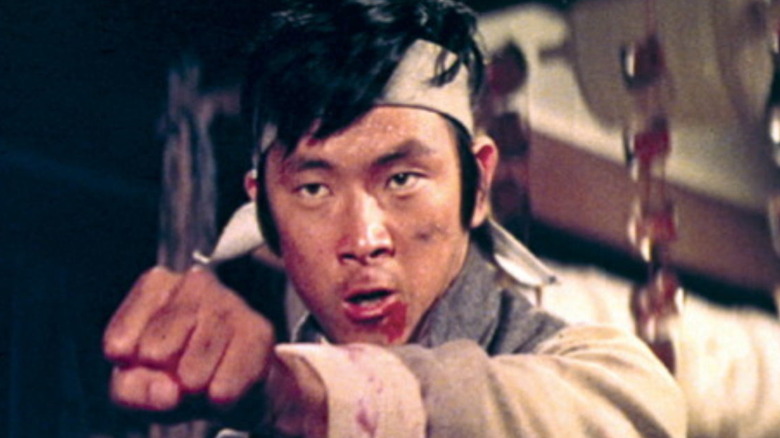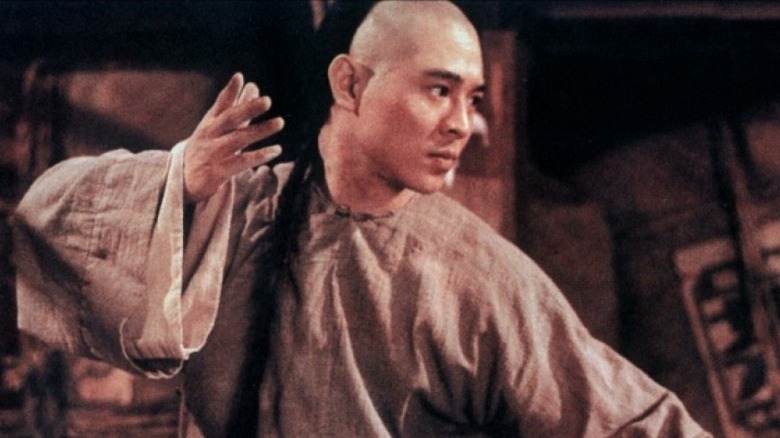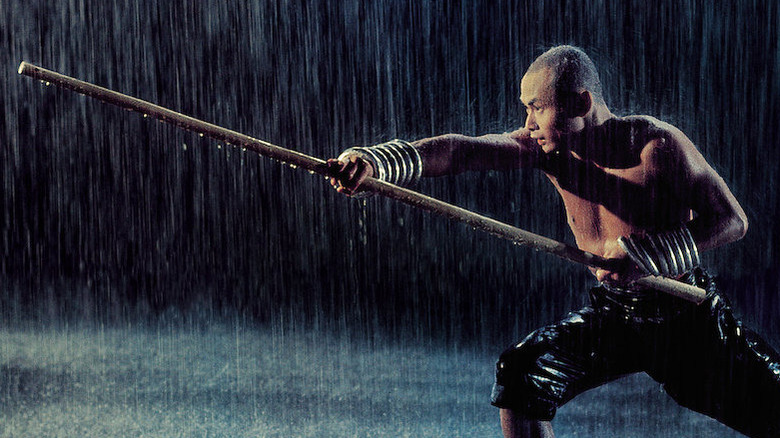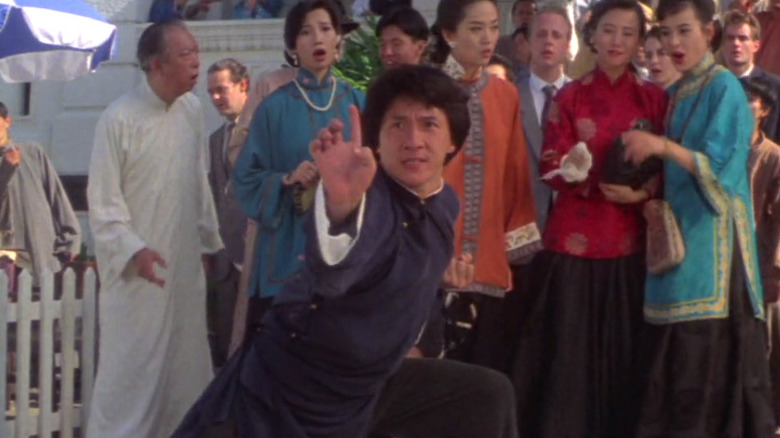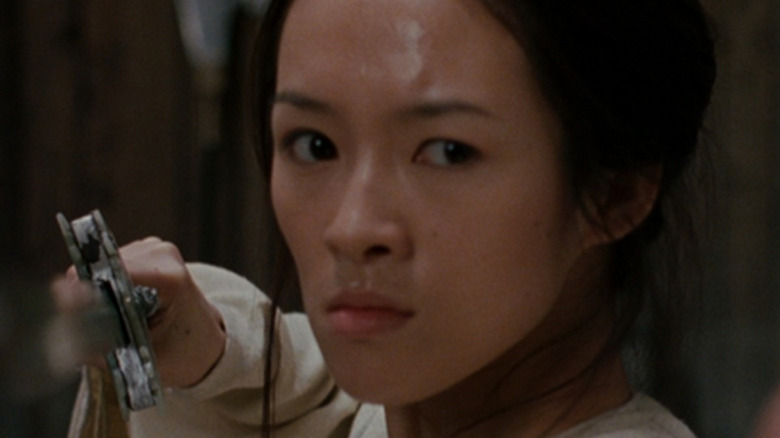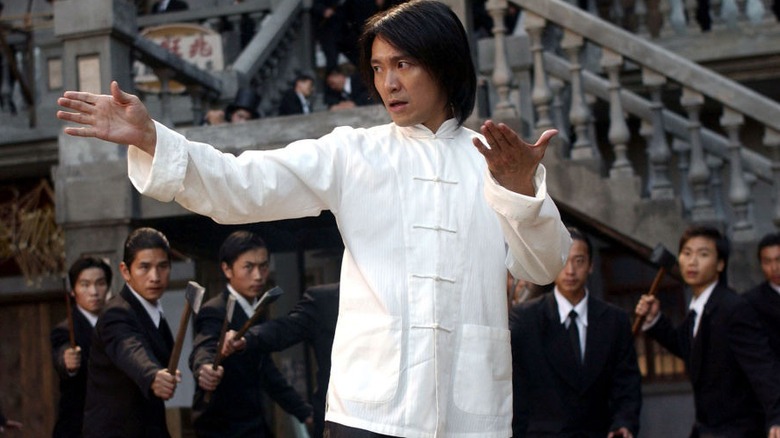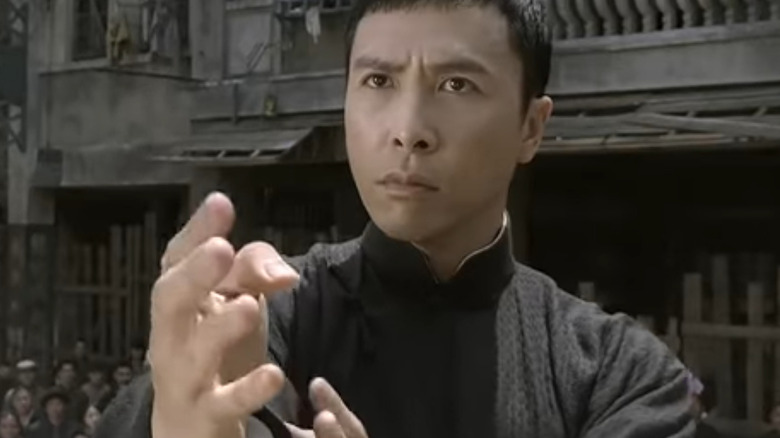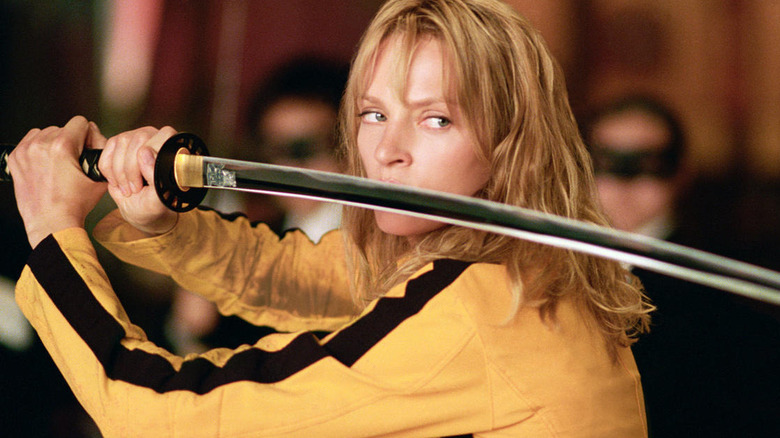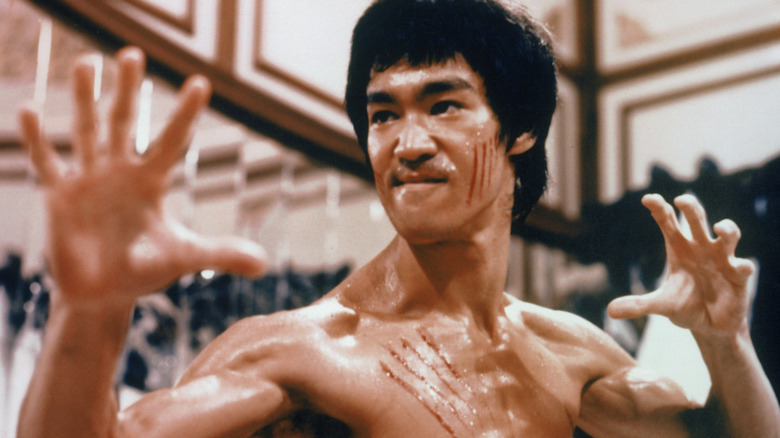The Best Kung Fu Movies Of All Time Ranked
There's really nothing like a good kung fu movie, is there?
A distinct product of Eastern cinema, the kung fu film is a genre unto itself, offering some of the most superbly-orchestrated hand-to-hand fight scenes you'll see anywhere on film. A subgenre of the more catch-all martial arts genre, the kung fu film is among the less-celebrated but still immensely enjoyable movie genres out there. Having given us legendary screen icons like Bruce Lee and Jackie Chan, kung fu films have inspired videogame franchises ("Mortal Kombat," "Street Fighter"), music (The Wu-Tang Clan, Kendrick Lamar), and even Hollywood auteurs like Quentin Tarantino and the Wachowskis, not always dabbling in the genre per se, yet frequently harnessing its aesthetic.
Given the sheer volume of kung fu films out there, it can be difficult knowing where to start for those interested in the genre. Don't worry, we're here to help; with an eye towards the novice, here are some of the greatest kung fu movies of all time, ranging from classic Hong Kong action flicks of the '70s (the genre's golden age) to more modern, comedic takes on butt-kicking kung fu.
12. Iron Monkey (1993)
Commonly praised as one of the best kung fu movies of the 1990s, "Iron Monkey" was proof that even though its golden period had ended, the kung fu genre still had some life in it. Based in part on Chinese folk hero Wong Fei-hung and his father's encounter with the mysterious martial artist known only as "the Iron Monkey," it's a film that boasts some first-rate action scenes, full of lightning-fast kicks and epic slow motion action.
Donnie Yen stars as Wong Kei-ying, a Chinese physician and skilled martial artist forced to battle the masked Robin Hood-like vigilante called the Iron Monkey after his son is kidnapped by a corrupt city official. When the Iron Monkey proves his heroism by saving Wong Kei-ying's son, the two fighters set out to combat the city's bureaucratic politicians together.
Originally released in 1993, "Iron Monkey" was warmly received by critics and moviegoers, earning an approval rating of 91% on Rotten Tomatoes and even being listed #99 on Empire magazine's "The 100 Best Films Of World Cinema" list. It would later see an expanded release in the US after Quentin Tarantino convinced Miramax to acquire the distribution rights, with the beloved director/kung fu super fan's stamp of approval broadening its appeal even further.
11. Five Deadly Venoms (1978)
A kung fu film with a loyal cult following, "Five Deadly Venoms" is a classic product of the Shaw Brothers Studio — the seeds of which launched in 1925 and would go on to become Hong Kong's largest production company.
Yang Tieh is a young martial artist instructed by his dying master to seek out his former students — all of whom have become powerful masters of a specific fighting style — eliminating any who are using their abilities for nefarious purposes. These five students' fighting styles have earned each a specific name (the Centipede, the Snake, the Scorpion, the Lizard, and the Toad, based on the "five poisonous creatures" from Chinese folklore), with Yang Tieh having been taught a little bit of each combat style.
By today's standards, "Five Deadly Venoms" may be viewed as somewhat cheesy and dated, but it is exactly this over-stylization that makes it an enjoyable, essential kung fu romp — and mandatory viewing for any would-be fan of the genre. One of the most influential kung fu movies ever made, it's been referenced in everything from "Kill Bill" (the name of Deadly Viper Assassination Squad being an homage) to 2Pac's "5 Deadly Venomz," not to mention the movie's dialogue appearing in several Wu-Tang Clan songs like "Da Mystery Of Chessboxin'" and "Intro (Shaolin Finger Jab)."
10. Police Story (1985)
After Bruce Lee's death in 1973, the kung fu film entered a strange state of limbo. At its peak of popularity but suddenly without its most prominent leading man, genre producers desperately scrambled for potential stars to succeed Lee. Few actors matched his intensity, gravitas, and onscreen presence; instead, they turned to an actor who had the physicality, but wanted to take the genre in a wholly unexpected direction.
"I wanted to be like a Chaplin or Buster Keaton," Jackie Chan told the New York Times in 1995. "But all the martial arts directors I worked with wanted me to copy Bruce Lee."
After making a name for himself with the 1978 Hong Kong kung fu comedic "Drunken Master" (and battling Bruce Lee in a blink-and-you'll-miss-it moment from "Enter the Dragon"), Chan tried and failed to break into Hollywood, leaving the American film industry dissatisfied and disappointed in the quality (and box office) of films like "The Big Brawl (aka "Battle Creek Brawl"). Resolving to make his own movie, Chan went to work co-writing, directing, and starring in "Police Story," the first in a series of successful action-crime movies — the first of which, according to Chan's autobiography, he still considers his greatest film.
"Police Story" stars Chan as a Hong Kong police detective framed for the murder of another officer by a powerful drug kingpin. Blending slapstick comedy with large-scale action sequences, "Police Story" was a massive blockbuster in Eastern markets when first released, winning the 1986 Hong Kong Film Award for Best Film. Matt Zoller Seitz of RogerEbert.com praised the movie's famous mall fight scene (in which Chan had to jump eight feet across a multi-story lobby and risk electrocution), calling it a "masterpiece of choreography" and "one of the greatest stunts in the history of movies." In 2016, it was ranked the fourth best action film in a Time Out poll consisting of critics, filmmakers, and stunt actors.
9. Master of the Flying Guillotine (1976)
A kung fu film within the wuxia genre (a martial arts movie blending elements of fantasy and magical realism, traditionally set in ancient China), "Master of the Flying Guillotine" may be lesser known than most other kung fu films that came at around the same time, but it remains an influential and enjoyable movie.
A sequel to director, co-writer, and star Jimmy Wang Yu's earlier "One Armed Boxer," "Master of the Flying Guillotine" sees Wang's one-armed boxer and master martial artist defending himself from a vengeful blind assassin wielding a deadly buzzsaw hat that decapitates anyone wearing it.
Named by Quentin Tarantino as one of his favorite films of all time (his "Kill Bill" antagonist, Gogo Yubari, even uses a similar weapon to the eponymous flying guillotine), it's easy to see Tarantino's attraction to the film. It's pure '70s camp, full of cartoonish violence and flashy, gloriously ridiculous fighting moves. As an example, in one of the film's most famous scenes, Jimmy Wang's boxer manages to punch the assassin through the roof and into his own coffin.
Since its release, "Master of the Flying Guillotine" has been praised by publications like The New York Times as being among the best kung fu films, and has even been referred to as the "Holy Grail of Hong Kong martial arts movies of the '70s" by Los Angeles Times' Kevin Thomas.
8. Once Upon a Time in China (1991)
In the 1990s the kung fu genre saw a resurgence in popularity, thanks in large part to films starring Donnie Yen and Jet Li, two of the most charismatic and proficient martial artists-turned-actors to come along after Bruce Lee and Jackie Chan. In the film that rocketed Li to stardom, the actor would appear as legendary folk hero Wong Fei-hung (who can be glimpsed as a young boy in "Iron Monkey" and has been played by dozens of actors in over a hundred Hong Kong films).
A physician as talented in the medical field as he is in kung fu, Li's Wong Fei-hung trains a local militia to combat a criminal martial arts syndicate, as well as encroaching Western colonizers. Praised by critics, "Once Upon a Time in China" retains an 88% approval rating on Rotten Tomatoes, and was nominated for Best Film at the 11th Hong Kong Film Awards (it won for Best Director and Best Action Choreography). Remembered today for its incredible action scenes (including a final battle that utilizes multiple bamboo ladders) and for Li using everything from an umbrella to bamboo sticks as lethal weapons, it's a story about retaining one's cultural roots in the face of rapid Westernization, a surprisingly political movie hidden under the guise of a kung fu flick.
7. The 36th Chamber of Shaolin (1978)
Another undisputed classic from Shaw Brothers Studio, "The 36th Chamber of Shaolin" is regarded by many kung fu cinema enthusiasts as one of the best kung fu films ever made, jumpstarting the careers of its director (Lau Kar-leung) and its star (Gordon Liu) in the Eastern film industry.
Liu plays a young student named Liu Yude, whose entire school is systematically killed off by a brutal government regime. Seeking vengeance, the student travels to a Shaolin temple in order to learn kung fu, and is put to the test when he must pass through the temple's 36 chambers, each emphasizing key combat and fighting techniques to sharpen one's mind and body. A rare film where the training scenes are as meticulously-orchestrated and fun to watch as the actual fight sequences, "The 36th Chamber of Shaolin" was a milestone in the kung fu genre, showing that, despite the drop-off in popularity that post-Bruce Lee kung fu films were suffering in the late '70s, some memorable films could emerge.
Praised by critics, it has an audience approval rating of 90% on Rotten Tomatoes, and was listed at #22 in Time Out's poll of the 101 best action movies. It was also a direct influence on the Wu-Tang Clan. In addition to referencing the film in the name of their debut album, "Enter the Wu-Tang (36 Chambers)," Wu-Tang Clan member Masta Killa took his name from one of the film's alternate titles, "The Master Killer."
6. The Legend of Drunken Master (1994)
Sequels rarely measure up to the success and popularity of the films they're following up on. However, "The Legend of Drunken Master" not only manages to match the strengths of its original movie — it surpasses it. Also known as "Legend Master II," "The Legend of Drunken Master" is a major improvement on the original "Drunken Master" in every conceivable way, featuring better stunts, better action, and better comedy.
Released 16 years after the original "Drunken Master," Chan once again stars as folk hero Wong Fei-hung, a master of drinking and martial arts, combining both to form his unique "drunken boxing" fighting style. Pressured by his father to give up drinking and fighting for good, Wong Fei-hung must decide between obeying his father's wishes or stopping a foreign plot to steal priceless artifacts from his homeland.
"The Legend of Drunken Master" earned near-universal acclaim, including a number of prestigious awards (including the 14th Hong Kong Film Award and the 31st Golden Horse Award for Best Action Choreography) following its release. In 2015, the British Film Institute included it on their "10 best action movies" list. In his review of the film for the Chicago Sun-Times, Roger Ebert wrote, "It may not be possible to film a better fight scene," in reference to the final showdown between Wong Fei-hung and one of the film's major antagonists.
5. Crouching Tiger, Hidden Dragon (2000)
Kung fu films seldom win or earn nominations from international film festivals. In 2000, however, a wuxia film broke through the mold, delivering an action-packed narrative with a surprising amount of tender emotion hidden beneath its violent surface.
In "Crouching Tiger, Hidden Dragon," Hong Kong action star Chow Yun-fat stars as veteran warrior Li Mu Bai, who entrusts his faithful 400-year-old sword known as the "Green Destiny" to his friend (Michelle Yeoh) when he decides to retire. When a nimble young thief steals the sword for herself, Mu Bui's friend embarks on a journey to recover it, facing her own complex feelings towards her old friend along the way.
Blending romance with kung fu doesn't always make for a great combo, but in director Ang Lee's very capable hands, a tender portrait of forbidden love is delivered between rapid-fire kicks and captivating sword fights. Universally-acclaimed upon release, "Crouching Tiger, Hidden Dragon" won more than 40 awards, earning an Oscar nomination for Best Picture, and winning for Best Foreign Language Film, Best Art Direction, Best Original Score and Best Cinematography (along with "Roma," it holds the record for the most Academy Award nominations held by a non-English language film). It's also far and away the highest-grossing foreign language film ever released in the US (according to Box Office Mojo).
4. Kung Fu Hustle (2004)
A modern kung fu film more along the lines of a spoof than an homage to the martial arts genre, "Kung Fu Hustle" was director, writer, and star Stephen Chow's follow-up to his hilarious hit "Shaolin Soccer." Satirizing the more recent stunts found in kung films of the early 2000s ("Hero" and "Crouching Tiger, Hidden Dragon," in particular), "Kung Fu Hustle" was designed as a parody of the classic kung fu films, featuring several retired genre actors in prominent roles.
In the film, Chow stars as Sing, an aspiring low-level criminal trying to make a name for himself as a legitimate bad guy by joining the infamous Axe Gang. When the Axe Gang begins to wreak havoc on a local slum called Pigsty Alley — only to find it populated by several kung fu masters who have gone into hiding — Sing must decide whether to join the gang or save the neighborhood from certain destruction.
While the fight scenes are incredibly well done, it's the movie's comedic style that makes "Kung Fu Hustle" so enjoyable. Abandoning the laws of physics completely, characters are able to move with cartoonish speed and agility, leading Roger Ebert to refer to it as "Jackie Chan and Buster Keaton meet Quentin Tarantino and Bugs Bunny" in his positive review. Praised by everyone from James Gunn (who said "Kung Fu Hustle" was "the greatest film ever made") to Bill Murray (who called it "the supreme achievement of the modern age in terms of comedy"), it may not have the most hard-hitting action, but it's definitely the funniest kung fu movie you're likely to find anywhere.
3. Ip Man (2008)
The kung fu genre may have reached its peak with Bruce Lee, but more recent movies have kept the genre alive for a new generation to enjoy. Foremost among these is "Ip Man," a fictionalized biopic focused on the grandmaster of the martial art, Wing Chun, known for training some of the world's greatest martial artists (including Lee).
The first in a five film series, "Ip Man" stars Donnie Yen as the eponymous martial artist, who faces constant challenges from local combat experts and professional soldiers trying to prove themselves during the Sino-Japanese War.
While the historical accuracy of the film is debatable, the success it received is not. Earning a positive reception from critics, the film would go on to launch a popular film franchise, ignite Yen's career, and earn heaps of awards (such as the 28th Hong Kong Film Award for Best Film, the Hong Kong Film Award and the Golden Horse Award for Best Action Choreography). In Variety Magazine's review of the film, Derek Elley wrote, "Yen, who's taking on real star charisma in middle age, is aces as Ip, with a simple dignity that exactly mirrors the movie's own and a gracefulness in combat that's very different from his trademark whiplash style."
On Rotten Tomatoes, the movie has an 86% approval rating, with the critical consensus stating, "At once beholden to the established conventions of the genre and delightfully subversive of them, 'Ip Man' is one of the most exciting — and refreshingly character-driven — martial arts films in years."
2. Kill Bill: Vol 1 (2003) and Kill Bill: Vol. 2 (2004)
A man who adores all things film, when Quentin Tarantino set out to create his own martial arts movie in the early 2000s, he blended all of his favorite B-movie genres together (kung fu films, Japanese samurai films, Italian giallo movies, and spaghetti Westerns) into the massive kung fu extravaganza that is "Kill Bill."
Spanning two films and clocking in at a total runtime of four hours, "Kill Bill" stars Uma Thurman as an initially nameless woman known only as the Bride, left for dead by her former top-notch mercenary team, led by her ex-lover, Bill (played by a charismatic David Carradine). Waking from the coma Bill and his gang put her in, Thurman's Bride embarks on a globe-trotting mission to hunt down all of her former teammates who wronged her, eventually coming face to face with Bill himself.
One of Tarantino's classics, the ingenuity of "Kill Bill" lies in its endless references to kung fu films near and dear to Tarantino's heart; the filmmaker throws a plethora into the movie (such as the Bride sporting the now iconic black and yellow tracksuit worn by Bruce Lee in his uncompleted "Game of Death"). A lovingly-made homage to a film genre Tarantino clearly holds dear, it was the subject of widespread critical praise, earning several BAFTA and Golden Globe nominations, including Best Actress (Thurman) and Best Supporting Actor (Carradine).
Like most of Tarantino's movies, it can be a bit too violent for some (namely the extremely gory sword battle scene at the end of "Volume 1"); for all its blood, however, it ranks among his best.
1. Enter the Dragon
In many ways, what Clint Eastwood or John Wayne was for the Western, Bruce Lee was for martial arts movies. But while Eastwood and Wayne had decades and dozens of films to establish their legacies, Lee did it in a fraction of the time.
In what would be Lee's final film before his untimely death at the age of 32, "Enter the Dragon" minted the screen icon as a skilled martial artist sent undercover to compete in a fighting tournament organized by a dangerous international criminal. Almost inarguably the most influential kung fu movie of all time, "Enter the Dragon" is considered Lee's masterpiece. It's also one of the most financially successful films ever made, grossing over 400 times its estimated budget of $850,000 (by the 2010s, the movie had earned about $350 million, or roughly $2.2 billion adjusted for inflation, via The New York Times).
At the time of its release, "Enter the Dragon" earned mixed to average reviews, although later critics would be far more generous, complimenting the movie's action, music, and Lee's performance. The New York Times' Howard Thompson wrote of the film, "The picture is expertly made and well-meshed; it moves like lightning and brims with color. It is also the most savagely murderous and numbing hand-hacker (not a gun in it) you will ever see anywhere." Further proof of the film's prestigious place in the kung fu genre came in the early 2000s, when the film was deemed "culturally, historically, or aesthetically significant" by the Library of Congress and selected for preservation in the US National Film Registry.
The enduring influence of "Enter the Dragon" can be found not only in nearly every kung fu film that has followed since, but in modern video game series, manga, and anime as well. The plot of the film resembles the basic premise of "Mortal Kombat," and the film has been cited as a key influence on the "Dragon Ball" franchise (the name "Dragon Ball" being a direct reference to "Enter the Dragon").
All these decades later, the film still shapes much of pop culture. Lee's fighting style in the film also had a major influence on the world of MMA; in the opening scene, Lee dons the now standard-UFC apparel of smaller shorts and kempo gloves, demonstrating several moves that would become commonly used in MMA bouts. According to UFC Hall of Famer Urijah Faber, "that was the moment" modern MMA was born.
"If you look at the way Bruce Lee trained, the way he fought, and many of the things he wrote, he said the perfect style was no style," UFC president Dana White said in 2020, calling Lee "the father of mixed martial arts." "You take a little something from everything. You take the good things from every different discipline, use what works, and you throw the rest away."
